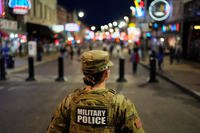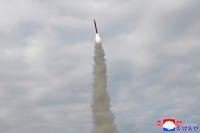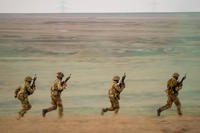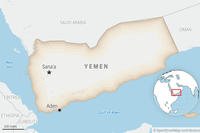Helicopter-borne U.S. special operations forces conducted a daring nighttime raid Saturday to fight their way into a compound and tunnel complex in northwest Syria that resulted in the death of long-hunted ISIS leader Abu Bakr al-Baghdadi, President Donald Trump announced Sunday.
Baghdadi, the self-declared ISIS "caliph," killed himself and three children by detonating a suicide vest as he fled down a tunnel with U.S. troops in pursuit, Trump said at a White House briefing.
"He ran into a dead-end tunnel, whimpering, crying and screaming all the way," said Trump, who watched the operation unfold with Joint Chiefs Chairman Gen. Mark Milley and others in the White House situation room Saturday night. "I got to watch much of it."
Baghdadi, subject of a $25 million bounty for information leading to his death or capture, "dragged three young children with him," Trump said.
"He died like a dog, he died like a coward," the president said.
There were no U.S. casualties in the raid, which Trump said killed "many" of Baghdadi's guards. But a U.S. canine was injured in the collapse of the tunnel and was brought back by American troops who flew safely out of the contested region, he added.
Through biometrics and DNA, troops at the scene confirmed the identity of Baghdadi, Trump said. Without doubt, "it was him," Trump said.
Trump did not specify which units participated in the raid, other than to say that eight helicopters were involved and all the services contributed. It was a flight of about one hour and 10 minutes "over dangerous territory" controlled by various factions, Trump said.
The raid reportedly involved between 50 and 70 troops, including members of the elite 1st Special Forces Operations Detachment, better known as Delta Force, from the Joint Special Operations Command in Fort Bragg, North Carolina, according to Fox News.
The operation reportedly originated from Irbil in the Kurdish region of Iraq. The troops had to cover about 475 miles to reach the target area by flying low with substantial fixed-wing U.S. air cover as escorts, Trump said.
Success also required cooperation with Russia, Turkey, Iraq and the Kurdish-led Syrian Democratic Forces, he said.
Russia "treated us great," Trump said. "They gave us some information that turned out to be helpful," he said, adding that Russian officials were told a U.S. operation would be underway in northwestern Syria and they voiced no objections.
Without confirming the raid or Baghdadi's death, Trump indicated Saturday night that a transformative event in the long U.S. campaign to inflict a permanent defeat on the Islamic State group had occurred. "Something very big has just happened," the president tweeted.
The nighttime raid posed enormous risk and difficulty of execution for the special operators, who had to cross into the conflict zones of Syria's Idlib province, where a mix of Islamic radicals and opposition fighters have been holding out against the forces of Syrian President Bashar al-Assad and Russian airstrikes.
The operation, first reported by Newsweek, also highlighted the dogged work of the CIA, likely the Special Activities Center, in providing the intelligence on Baghdadi's location in what could be considered an improbable hideout in territory where militant groups opposed to ISIS hold sway.
In carrying out the complex raid, the U.S. military had to navigate the shifting cross-currents of great power disputes between Russia and the U.S., as well as the brutal sectarian conflicts spawned by Syria's civil war that have left the region a patchwork of enclaves controlled by militant factions.
The U.S. also had to be wary of the interests of NATO-ally Turkey, which maintains observation posts in Idlib province and has triggered chaos in northeastern Syria by invading to attack the Kurdish-led and U.S. partnered SDF.
In a Tweet early Sunday, Turkey's defense ministry claimed to have cooperated in the operation against Baghdadi.
"Prior to the U.S. operation in Idlib Province of Syria last night, information exchange and coordination between the military authorities of both countries took place," ministry officials said.
Defense Secretary Mark Esper said the death of Baghdadi was a "devastating blow" to ISIS, whose fighters swept out of eastern Syria in pickup trucks in 2014 and into Iraq where the national security forces collapsed.
Baghdadi's ascent to power was capped by his appearance in the grand mosque of Mosul in northwestern Iraq, where he declared the creation of an ISIS caliphate and himself as the caliph.
"This is not just their leader, it's their founder," Esper said Sunday on CNN's "State of the Union" program.
"He was an inspirational leader in many ways. He formed ISIS in 2014, he led to establishing the physical caliphate throughout the region, so this is a major blow to them," Esper said, adding that "we're going to watch carefully the next steps. And as a new leader and leaders pop up we'll go after them as well."
A Two-Hour Fight
In his opening statement at the White House, Trump said U.S. troops were on the ground for about two hours.
Sporadic gunfire was aimed at the helicopters enroute to the target area, Trump said, but it was unclear whether the helicopters took any hits.
In attacking the house where they believed Baghdadi was hiding, the troops avoided a door that may have been booty-trapped. They instead blew holes in the side of the building to gain entry, Trump said.
As the helicopters began their approach, they were again fired on from the ground. But the ground fire was suppressed by return fire from the helicopters, Trump said.
"They were very low and very fast," Trump said of the helicopters.
Trump said several enemy fighters were killed in the raid, along with two women believed to be Baghdadi's wives.
He described the contacts with the Russians to inform them of the operation as deliberately vague: "We told them we were coming in but didn't tell them why."
Final preparations for the raid began about two weeks ago, Trump said, but the go-ahead order was called off at least twice as intelligence officials sought to pin down Baghdadi's location.
The London-based monitoring group Syrian Observatory for Human Rights, which has sources on the ground in Syria, said groups linked to ISIS were in the area of the house outside the town of Barisha in Idlib province.
The helicopters targeted the house and a car nearby, the Syrian Observatory group said, and there were firefights as the U.S. troops breached the walls of the house. At least nine fighters on the ground were killed by the U.S. troops, the Syrian Observatory group said.
Trump said he held off the usual notification to House Speaker Rep. Nancy Pelosi, D-Calif., and other congressional leaders before and immediately after the raid for fear of leaks compromising the operation. Congressional leaders were informed before the 2011 raid in Pakistan that killed al Qaeda leader Osama bin Laden.
Trump described Baghdadi as a brutal killer who caused much harm and death.
"He will never again harm another innocent man, woman or child," Trump said. "The forced religious conversions, the orange suits prior to many beheadings, all of which were openly displayed for the world -- this was all Abu Bakr al-Baghdadi's work.
"He was vicious and violent, and he died in a vicious and violent way, as a coward, running and crying."
From Obscure Cleric to ISIS Leader
According to U.S. government and military reports over the years, Baghdadi was an Iraqi from Samarra north of Baghdad originally named Ibrahim Awad Ibrahim Ali al-Badri.
He was believed to be about 48 years old. He studied as an Islamic cleric in Baghdad and was radicalized by the 2003 U.S. invasion.
In 2004, he was arrested in Fallujah for his connections to the al Qaeda in Iraq group and was jailed in U.S. prisons at Abu Ghraib and Camp Bucca, where he had contacts with other jihadi leaders. He was released in 2009.
As U.S. operations decimated the ranks of Al Qaeda in Iraq, Baghdadi fled to Syria. After assuming leadership positions in the nascent Islamic State group, Baghdadi was declared the terror group's leader in 2010.
In 2013, Baghdadi declared the formation of the Islamic State of Iraq and the Levant (ISIL), and also broke with al Qaeda. ISIL later became the Islamic State of Iraq and Syria (ISIS).
In the years since, reports from the region have suggested that Baghdadi either was ill, or had been wounded in U.S. anti-terror operations, but all of the reports have been unconfirmed.
At the White House Sunday, Trump said the video and audio of the raid in the situation room unfolded "like a movie," recalling the photos released by the White House of former President Barack Obama and Secretary of State Hillary Clinton watching the SEAL Team Six raid in 2011 that killed bin Laden.
Richard Sisk can be reached at Richard.Sisk@Military.com.














